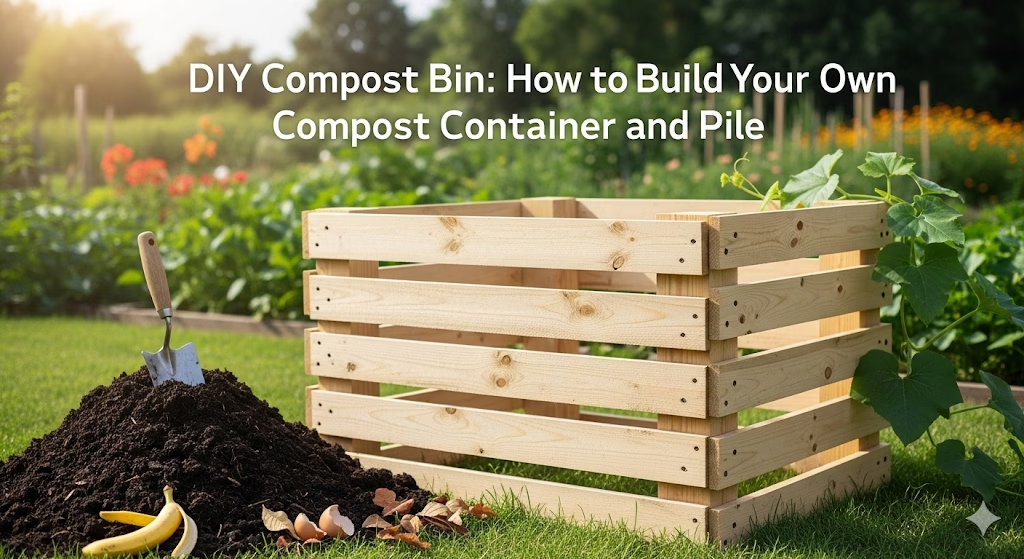Introduction
Composting is one of the easiest and most effective ways to recycle kitchen and garden waste into nutrient-rich soil. But you don’t need expensive equipment to get started—a simple DIY compost bin or homemade compost container can do the job perfectly.

In this guide, you’ll learn how to build a DIY compost bin, compost container, and compost pile using affordable or repurposed materials. We’ll also cover composting basics, safety tips, and how to use your finished compost.
Why Make a DIY Compost Bin?
- Affordable: Save money by building with recycled materials.
- Customizable: Build the size and type you need for your space.
- Eco-Friendly: Repurpose old wood, plastic barrels, or wire mesh.
- Efficient Waste Management: Reduce food and yard waste sent to landfills.
- Soil Health: Produce nutrient-rich compost for your garden naturally.
Looking for composting tips for your backyard? Visit Agzora.com.
Choosing the Right DIY Compost System
When building your compost setup, you can pick from three main styles:
1. DIY Compost Bin
A closed container, often made from wood, pallets, or barrels. Great for urban or suburban spaces.
2. DIY Compost Container
Smaller and portable, made from buckets, storage tubs, or plastic bins. Perfect for patios, balconies, or small gardens.
3. Compost Pile DIY
An open heap of organic material. Ideal for rural gardens or those with plenty of yard space.
Materials You Can Use for a DIY Compost Bin
- Wooden pallets
- Wire mesh or chicken wire
- Plastic barrels or drums
- Large buckets or storage bins
- Bricks or concrete blocks
- Reclaimed lumber
According to the EPA Composting Guide, using local, recycled materials is both cost-effective and environmentally friendly.
How to Build a DIY Compost Bin (Step-by-Step)
Option 1: Wooden Pallet Compost Bin
- Gather four wooden pallets.
- Stand three upright to form a U-shape.
- Attach with screws or wire.
- Add the fourth pallet as a hinged front gate for easy access.
Best For: Medium to large gardens.
Option 2: Plastic Barrel Compost Bin
- Take a 55-gallon plastic barrel with a lid.
- Drill holes around the sides for aeration.
- Place the barrel on a stand and add a handle for turning (optional).
Best For: Small backyards or suburban homes.
Option 3: Storage Bin Compost Container
- Use a large plastic storage tote with a tight lid.
- Drill 8–10 small holes in the sides and bottom for airflow.
- Add a tray underneath to catch excess liquid.
Best For: Balconies, patios, or limited space.
Option 4: Wire Mesh Compost Bin
- Cut a piece of wire mesh (about 10 feet long).
- Form it into a circle and secure ends together.
- Place directly on the ground in a sunny spot.
Best For: Fast composting with good airflow.
Option 5: Compost Pile DIY Setup
- Pick a flat, shady spot in your yard.
- Start layering “greens” (food scraps, grass) and “browns” (leaves, straw).
- Cover with soil or finished compost.
- Turn pile every 1–2 weeks.
Best For: Large gardens and farms.
Managing Your DIY Compost Bin
To make sure your compost breaks down quickly and safely:
- Balance materials: Use 2 parts browns to 1 part greens.
- Moisture: Keep damp, like a wrung-out sponge.
- Turning: Stir or rotate every 1–2 weeks to add oxygen.
- Temperature: Aim for 130–150°F to kill weed seeds and pathogens (Cornell Composting Guide).
- Patience: Compost is ready in 3–6 months.
Using Finished Compost
- Vegetable Gardens: Mix 1–2 inches into soil before planting.
- Lawns: Top-dress thinly to improve grass growth.
- Flower Beds: Spread around perennials and shrubs.
- Container Plants: Blend with potting soil (25–30% compost).
DIY Compost Bin vs. Store-Bought Bins
| Feature | DIY Compost Bin | Store-Bought Bin |
|---|---|---|
| Cost | Low (often free) | $100–$300 |
| Customization | Fully customizable | Limited sizes and styles |
| Durability | Depends on materials | Often weatherproof |
| Eco-Impact | Uses recycled materials | Manufactured |
| Learning Curve | More DIY effort | Easier setup |
Safety Tips for Composting at Home
- Avoid meat, dairy, and oily foods that attract pests.
- Wear gloves when handling compost.
- Let compost cure fully before adding to edible crops.
- Keep compost bins covered to reduce odor and flies.
For safe handling, see CDC guidelines on manure and compost safety.
FAQs About DIY Compost Bins
1. Can I make a compost bin without tools?
Yes—wire mesh or a simple compost pile requires no tools.
2. What is the cheapest way to build a compost bin?
Using free wooden pallets or leftover wire mesh is the most affordable option.
3. Can I compost indoors with a DIY container?
Yes, use a plastic storage bin or bucket with holes for airflow. Add only kitchen scraps and avoid meat or dairy.
4. How long does compost take to finish?
Typically 3–6 months, depending on temperature, moisture, and materials used.
5. Is a compost pile as effective as a bin?
Yes, but bins keep compost more contained, reduce pests, and maintain heat better.
Conclusion
Building a DIY compost bin or compost container is a budget-friendly and eco-conscious way to recycle waste and enrich your soil. Whether you choose a wooden pallet setup, a plastic barrel tumbler, or a simple compost pile DIY, each method will help create nutrient-rich compost for your plants.
By taking control of your composting system, you not only reduce household waste but also create healthier soil for stronger, more productive gardens.
Call to Action: Ready to start composting at home? Explore more composting and organic gardening tips at Agzora.com.






